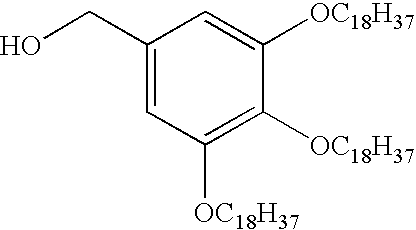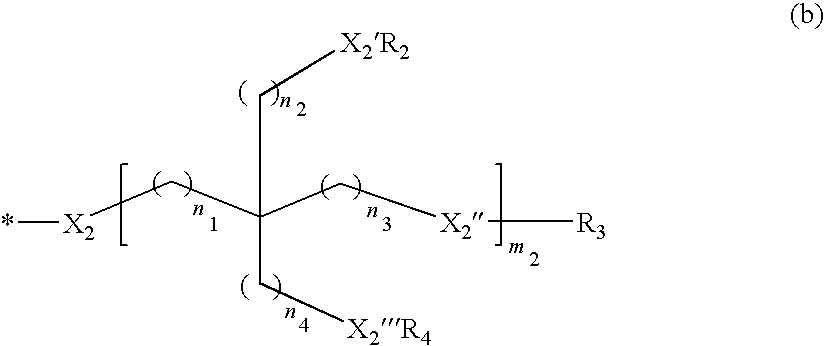Diphenylmethane compound
a technology of methylmethane and compound, applied in the field of methylmethane compounds, can solve the problems of long time, difficult reaction product analysis, and difficult reaction product analysis on the carrier, and achieve the effect of superior broad utility and stability
- Summary
- Abstract
- Description
- Claims
- Application Information
AI Technical Summary
Benefits of technology
Problems solved by technology
Method used
Image
Examples
reference example 1
Alkylation of 2,3,4-trihydroxybenzophenone
[0275]
[0276]To 2,3,4-trihydroxybenzophenone (1.60 g, 6.95 mmol) was added DMF (30 ml), 1-bromooctadecane (7.3 g, 21.9 mmol) and potassium carbonate (4.32 g, 31.3 mmol), and the mixture was stirred at 80° C. overnight. The reaction mixture was cooled to room temperature, chloroform (100 ml) was added, and 1N hydrochloric acid (30 ml) was further added dropwise. After stirring, the mixture was partitioned, and the organic layer was washed with 1N hydrochloric acid (30 ml) and water (30 ml). The organic layer was evaporated under reduced pressure, and the residue was washed with methanol (30 ml). The obtained precipitate was slurry washed with methanol (45 ml) to give 2,3,4-trioctadecanoxybenzophenone (6.35 g, 6.43 mmol, yield 93%).
[0277]1H-NMR (CDCl3 / 300 MHz)
[0278]0.88 (9H, t, J=6.6, C17H34—CH3) 1.00-1.60 (92H, br, Alkyl-H) 1.74 (2H, m, —O—CH2—CH2—C16H33) 1.84 (2H, m, —O—CH2—CH2—C16H33) 3.88 (2H, t, J=6.9, —O—CH2—C17H35) 4.00 (4H, m, —O—CH2—C1...
example 1
Reduction of 2,3,4-trioctadecanoxybenzophenone
[0279]
[0280]To 2,3,4-trioctadecanoxybenzophenone (3 g, 3.04 mmol) obtained in Reference Example 1 were added chloroform (30 ml), methanol (3 ml) and sodium borohydride (346 mg, 9.14 mmol), and the mixture was stirred at 45° C. overnight. The reaction mixture was cooled to room temperature and 1N hydrochloric acid (15 ml) was added dropwise. After stirring, the mixture was partitioned, and the organic layer was washed with water (15 ml×3). The organic layer was evaporated under reduced pressure, and acetonitrile (30 ml) was added to the residue. The precipitate was collected by filtration to give 2,3,4-trioctadecanoxybenzhydrol (2.91 g, 2.94 mmol, yield 97%).
[0281]1H-NMR (CDCl3 / 300 MHz)
[0282]0.88 (9H, t, J=6.6, C17H34—CH3) 1.10-1.65 (92H, br, Alkyl-H) 1.65-1.90 (4H, m, —O—CH2—CH2—C16H33) 3.03 (1H, br, s, —OH) 3.72 (1H, dt, J=6.6, 9.0, —O—CH2—C17H35) 3.95 (5H, m, —O—CH2—C17H35) 5.93 (1H, s, Ar—CHOH-Ph) 6.59 (1H, d, J=8.7, Ph C5-H) 6.83 (1H...
example 2
Fmoc amination of 2,3,4-trioctadecanoxybenzhydrol
[0283]
[0284]To 2,3,4-trioctadecanoxybenzhydrol (650 mg, 657 μmol) obtained in Example 1 were added toluene (10 ml) and Fmoc-NH2 (189 mg, 790 μmol), and the mixture was warmed to 50° C. in an oil bath. Methanesulfonic acid (6.4 μl, 99 μmol) was added, and the mixture was heated to 100° C. and stirred for 6 hours. After confirmation of disappearance of a benzhydrol type anchor, the mixture was cooled to room temperature. Toluene (5 ml) and 5% aqueous sodium hydrogen carbonate (10 ml) were added and the mixture was stirred. After partitioning, the organic layer was further washed with water (10 ml×2). The organic layer was evaporated under reduced pressure, and the residue was washed with methanol (10 ml) to give N-Fmoc-[phenyl(2,3,4-trioctadecanoxyphenyl)methyl]amine (788 mg, yield 98%).
[0285]1H-NMR (CDCl3 / 300 MHz)
[0286]0.88 (9H, t, J=6.6, C17H34—CH3) 1.10-1.65 (92H, br, Alkyl-H) 1.65-1.90 (4H, m, —O—CH2—CH2—C16H33) 3.40-3.50 (1H, br, m...
PUM
| Property | Measurement | Unit |
|---|---|---|
| Carbon number | aaaaa | aaaaa |
| Aliphatic | aaaaa | aaaaa |
Abstract
Description
Claims
Application Information
 Login to View More
Login to View More - R&D
- Intellectual Property
- Life Sciences
- Materials
- Tech Scout
- Unparalleled Data Quality
- Higher Quality Content
- 60% Fewer Hallucinations
Browse by: Latest US Patents, China's latest patents, Technical Efficacy Thesaurus, Application Domain, Technology Topic, Popular Technical Reports.
© 2025 PatSnap. All rights reserved.Legal|Privacy policy|Modern Slavery Act Transparency Statement|Sitemap|About US| Contact US: help@patsnap.com



